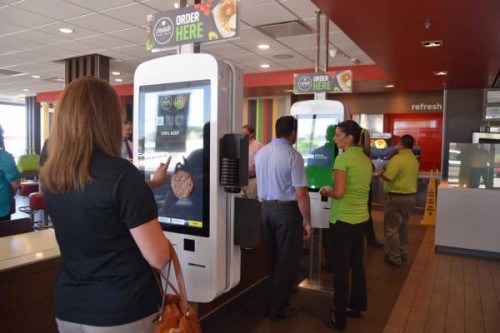


05/15/2017
The video piece from an Albany, New York, TV station starts out well enough, showing how automation is moving into jobs like supermarket checkout, restaurant cashier and cab driving.
But the piece wanders into sketchy territory when it poses a hopeful retraining message. Certainly the schools need to teach more tech-oriented curricula that will prepare young people for the jobs of the future. But not everyone can be a robotic engineer or even a mechanical engineering technician with a two-year degree. Well educated people forget how many Americans aren’t, and it skews the debate.
Plus there won’t be enough tech-connected positions for all the people displaced by the automation juggernaut. Businesses are investing in advanced software and machines in order to save money by cutting labor costs. The press wants to calm fears that are developing in the public, but it’s not being honest. Yes, there will be new jobs created by the tech revolution, but not enough in total numbers to make up for the jobs lost. The articles written to reassure people about the techno-future are practically becoming a sub-genre of tech writing and they appear nearly every day.
But the warnings from automation experts are much more convincing. Automation job loss has been happening for a while — worsening the last recession — and its effects will only increase. The nation needs an honest dialogue about how we can handle the automation revolution to the economy and the world of work.
At the very least, the US government should end immigration, because it is rapidly becoming an obsolete institution in the coming age of automation. We certainly won’t need to import human workers when machines are doing the jobs.
Below, digital ordering in restaurants is becoming more common as machines become cheaper and more capable, while workers’ wage demands accelerate the change.

Here’s the text version of WNYT’s report:
In Depth: The human cost of automation, WNYT, May 8, 2017
Jobs are disappearing in the Capital Region as everyday tasks are automated. It’s expected to get worse in the future as computers and robots get faster and more efficient.
The concern over machines replacing humans for certain jobs is nothing new. The Industrial Revolution brought on riots with people raging against machines that took their jobs. Today, these machines are even smarter and they’re going after jobs that were once automation proof.
The Digital Revolution as it’s called, is transforming the labor market.
Self-checkout systems are popping up in many places. For example, the Price Chopper in Latham, assisting customers. Human cashiers at supermarkets and fast food restaurants may be phased out altogether in the future.
Self-driving cars will be replacing cab drivers. A recent study done in the United Kingdom suggests that 38 percent of jobs in the United States could be in jeopardy by the early 2030s because of automation.
“These days, at a fraction of the cost, at a fraction of the effort, you can integrate the robots together and do much more powerful things,” noted Dr. John Wen, a professor at RPI.
With faster computers, automation is getting easier. Wen is on the cutting edge at RPI. Knowledge from robotics developed with some of his students could be used by NASA in the future, or for other uses. For example, a robot that could be used in the home for someone with a disability or a robot to help move big objects.
“The set up over here is with two robots or multiple robots, collaboratively handling a very heavy load,” pointed out Wen, showing off some of the robots.
Similar types of robots are already in the workforce performing complicated tasks, making today’s manufacturing more productive since the Industrial Revolution. Companies are simply making a lot more stuff with fewer people. However, Dr. Wen says automation is not eliminating human workers. He envisions a future with machines collaborating with humans to be even more productive.
“I think there will be even more jobs. To be honest right now, while we hear about a lot of the tech companies, engineering companies, we don’t have enough engineers to really fill those jobs,” explained Wen.
His engineering students are getting high paying jobs already straight out of RPI.
“I think for sure robots in the future will definitely be helping the workforce,” noted Greg Greber, an RPI student headed to Lockheed Martin once he graduates.
If RPI sounds intimidating, experts say high school students and people looking for a second career can consider a community college.
Doug Baxter, who teaches mechanical engineering at Hudson Valley Community College, says he’s turning companies away when they ask for new graduates.
“We cannot provide enough students to the local workforce of the caliber that they’re looking for,” noted Baxter.
The new jobs being created of course require a lot more math and science. Baxter says the school is seeing a good number of adult students coming back to take advantage of the computers and engineering programs.
“They’re all coming back because they want to take it to that next level. They want to do the engineering and the design side,” explained Baxter.
The reality is Baxter says machines will still need people. The challenge for society is to train those people in the workforce and students currently in school to fill the jobs of the future.